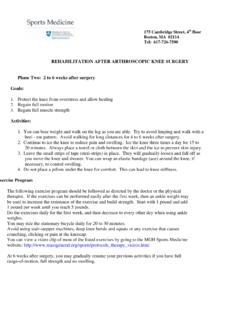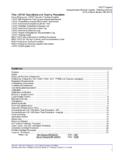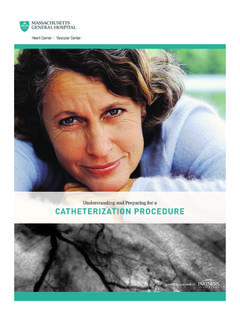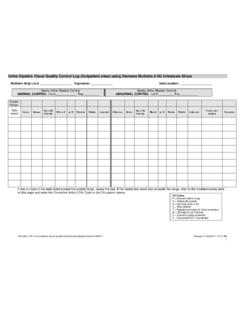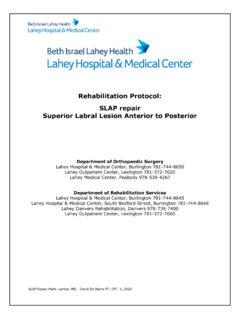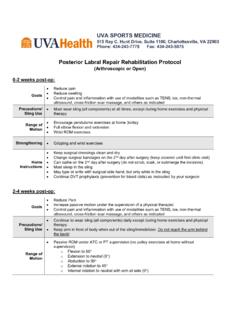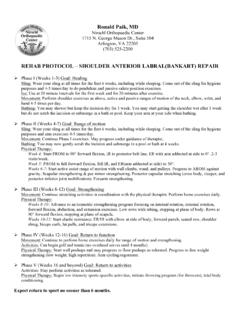Transcription of Rehabilitation Protocol for Bankart Repair
1 Rehabilitation Protocol for Bankart Repair This Protocol is intended to guide clinicians and patients through the post-operative course of a Bankart Repair . Specific interventions should be based on the needs of the individual and should consider exam findings and clinical decision making. If you have questions, contact the referring physician. Considerations for the Post-operative Bankart Repair Rehabilitation Program Many different factors influence the post-operative Bankart Repair Rehabilitation outcome, including severity of the damage to the labral and capsular structures and individual patient factors including co-morbidities. Post-operative Complications If you develop a fever, unresolving numbness/tingling, excessive drainage from the incision, uncontrolled pain or any other symptoms you have concerns about you should contact the referring physician. PHAS E I : IM MEDI AT E POST-OP (0-3 W E EKS AF TE R S UR GER Y) Rehabilitation Goals Protect surgical Repair Reduce swelling, minimize pain Maintain UE ROM in elbow, hand and wrist Gradually increase shoulder PROM Minimize substitution patterns with AAROM Minimize muscle inhibition Patient education Sling Neutral rotation Use of abduction pillow in 30-45 degrees abduction Use at night while sleeping Precautions No shoulder AROM No lifting of objects No supporting of body weight with hands Intervention Swelling Management Ice, compression Range of motion/Mobility PROM: ER<20 scapular plane, Forward elevation <90, pendulums, seated GH flexion table slide AROM: elbow, hand, wrist AAROM: Active assistive shoulder flexion, shoulder flexion with cane, cane external rotation stretch Strengthening (Week 2) Periscapular.
2 Scap retraction, prone scapular retraction, standing scapular setting, supported scapular setting, inferior glide, low row Ball squeeze Criteria to Progress 90 degrees shoulder PROM forward elevation 20 degrees of shoulder PROM ER and IR in the scapular plane Palpable muscle contraction felt in scapular and shoulder musculature No complications with Phase I PHAS E I I: IN TER ME DIATE POS T-OP (4-6 WEE KS AF TE R S UR GERY) Rehabilitation Goals Continue to protect surgical Repair Reduce swelling, minimize pain Gradually increase shoulder PROM Minimize substitution patterns with AAROM/AROM Patient education M as sa c h u se tt s G en era l H o spi ta l S po rts M e di ci ne 2 Sling Start to wean out of sling Precautions No lifting of objects No supporting of body weight with hands Intervention *Continue with Phase I interventions Range of motion/Mobility PROM: ER<50 scapular plane, ER @ 90 ABD <45, Forward elevation <135, horizontal table slide AAROM: washcloth press up, seated table slides, seated shoulder elevation with cane, wall climbs AROM: elevation < 115, supine flexion, salutes, supine punch, seated shoulder elevation with cane and active lowering Strengthening Rotator cuff: internal external rotation isometrics Periscapular: Row on physioball, shoulder extension on physioball, rowing, lawn mowers, robbery, serratus punches Criteria to Progress 135 degrees shoulder PROM forward elevation 50 degrees shoulder PROM ER and IR in scapular plane 45 degrees shoulder PROM ER in 90 degrees ABD 115 degrees shoulder AROM forward elevation Minimal substitution patterns with AAROM/AROM Pain < 2/10 No complications with Phase II PHAS E I II.
3 I NTE RME DIATE POS T-OP CON TD (7-8 W EE KS AFT ER S URGE RY) Rehabilitation Goals Do not overstress healing tissue Reduce swelling, minimize pain Gradually increase shoulder PROM/AROM Initiate rotator cuff strengthening Progress periscapular strength Improve dynamic shoulder stability Gradually return to full functional activities Patient education Sling Discontinue Precautions No lifting of heavy objects (>10 lbs) Intervention *Continue with Phase I-II interventions Range of motion/Mobility PROM: ER<65 scapular plane, ER @ 90 <75, Forward elevation <155 AAROM: Pulleys AROM: Elevation <145, supine forward elevation with elastic resistance to 90 degrees Strengthening Rotator cuff: side-lying external rotation, standing external rotation w/ resistance band, standing internal rotation w/ resistance band, internal rotation, external rotation Periscapular: Resistance band shoulder extension, resistance band seated rows, push-up plus on knees, tripod, pointer, prone shoulder extension Is, resistance band forward punch, forward punch Motor Control Internal and external rotation in scaption and Flex 90-125 (rhythmic stabilization) IR/ER and Flex 90-125 (rhythmic stabilization) Quadruped alternating isometrics and ball stabilization on wall Criteria to Progress 155 degrees shoulder PROM forward elevation 65 degrees shoulder PROM ER and IR in scapular plane 75 degrees shoulder PROM ER in 90 degrees ABD 145 degrees shoulder AROM forward elevation Pain < 2/10 M as sa c h u se tt s G en era l H o spi ta l S po rts M e di ci ne 3 PHAS E IV.
4 T RANS ITI ONAL POST-OP (9-11 WE E KS AFT ER SURGERY) Rehabilitation Goals Do not overstress healing tissue Gradually increase shoulder PROM/AROM Progress rotator cuff strengthening Progress periscapular strength Improve dynamic shoulder stability Precautions No lifting of heavy objects (> 10 lbs) Intervention *Continue with Phase II-III interventions Range of motion/mobility PROM: Full AROM: Full Strengthening Rotator cuff: sidelying ABD standing ABD, scaption and shoulder flexion to 90 degrees elevation Periscapular: T and Y, T exercise, push-up plus knees extended, prone external rotation at 90 degrees, wall push up, W exercise, resistance band Ws, dynamic hug, resistance band dynamic hug Elbow: Biceps curl, resistance band bicep curls and triceps Stretching IR behind back with towel, sidelying horizontal ADD, sleeper stretch, triceps and lats, doorjam series Motor Control PNF D1 diagonal lifts, PNF D2 diagonal lifts Field goals Criteria to Progress Full pain-free PROM and AROM Minimal to no substitution patterns with shoulder AROM Performs all exercises demonstrating symmetric scapular mechanics Pain < 2/10 PHAS E V: ST RE NGT H ENI NG POS T-OP (12-16 W EE KS AF TER S URG ERY) Rehabilitation Goals Maintain pain-free ROM Enhance functional use of upper extremity Intervention *Continue with Phase II-V interventions Strengthening Rotator cuff.
5 External rotation at 90 degrees, internal rotation at 90 degrees, resistance band standing external rotation at 90 degrees, resistance band standing internal rotation at 90 degrees Motor control Resistance band PNF pattern, PNF D1 diagonal lifts w/ resistance, diagonal-up, diagonal-down Wall slides w/ resistance band Stretching External rotation (90 degrees abduction), hands behind head Criteria to Progress Clearance from MD and ALL milestone criteria below have been met QuickDASH PENN Upper Extremity Functional Assessment o Full pain-free PROM and AROM o Joint position sense 5 degree margin of error o Strength 85% of the uninvolved arm o ER/IR ratio 64% o Scapula Dyskinesis Test symmetrical o Functional Performance and Shoulder Endurance Tests 85% of the uninvolved arm o Males 21 taps; females 23 taps on CKCUEST Return-to-sport testing can be performed at MGH Sports Physical Therapy, if necessary Negative impingement and instability signs Performs all exercises demonstrating symmetric scapular mechanics M as sa c h u se tt s G en era l H o spi ta l S po rts M e di ci ne 4 PHAS E VI I.
6 EARLY R ET URN-TO-SPORT ( 4-6 MON TH S AFTE R SUR GERY) Rehabilitation Goals Maintain pain-free ROM Continue strengthening and motor control exercises Enhance functional use of upper extremity Gradual return to strenuous work/sport activity Intervention *Continue with Phase II-VI interventions See specific return-to-sport/throwing program (coordinate with physician) Criteria to Progress Last stage-no additional criteria Return-to-Sport For the recreational or competitive athlete, return-to-sport decision making should be individualized and based upon factors including level of demand on the upper extremity, contact vs non-contact sport, frequency of participation, etc. We encourage close discussion with the referring surgeon prior to advancing to a return-to-sport Rehabilitation program. Revised April 2019 Contact Please email with questions specific to this Protocol References DeFroda SF, Mehta N, Owens BD. Physical therapy protocols for arthroscopic Bankart Repair .
7 Sports Health. 2018. May/June: 250-258. Gaunt BW, McCluskey GM, Uhl TL. An electromyographic evaluation of subdividing active-assistive shoulder elevation exercises. Sports Health. 2010. 2 (5): 424-432. Gaunt BW, Shaffer MA, et al. The American Society of Shoulder and Elbow Therapists consensus Rehabilitation guideline for arthroscopic anterior capsulolabral Repair of the shoulder. JOSPT. 2010. 40 (3): 155-168. Kibler, , Sciascia, A. D., Uhl, T. L., et al. Electromyographic analysis of specific exercises for scapular control in early phases of shoulder Rehabilitation . The American Journal of Sports Medicine. 2008. 36(9): p. 1789-1798. Uhl TL, Muir TA, et al. Electromyographical assessment of passive, active assistive, and active shoulder Rehabilitation exercises. PM R. 2010. 2: 132-141. M as sa c h u se tt s G en era l H o spi ta l S po rts M e di ci ne 5 Upper Extremity Functional Assessment Patient Name: MRN: Date of Injury/Surgery: Surgery/Surgeon: Concomitant Injuries/Procedures: _____ _ Operative Limb Non-operative Limb Limb Symmetry Index Passive range of motion.
8 ER-0-IR at 90 degrees ABD - 0 - - 0 - - Joint position sense-mid range (3 trials each limb) - Joint position sense-end range (3 trials each limb) - External rotation strength (average/3 trials) External rotation in scapular plane External rotation in 90 degrees abduction Eccentric external rotation in scapular plane Internal rotation strength (average/3 trials) Internal rotation in scapular plane Internal rotation in 90 degrees abduction Ratio ER/IR in scapular plane Ratio ER/IR in 90 degrees abduction Periscapular strength (average/3 trials) Middle Trapezius Lower Trapezius Motor Control Scapular Dyskinesis Test Symmetry: Y or N Functional Performance Tests (average /3 trials) Upper Quarter Y-Balance Closed Kinetic Chain Upper Extremity Stability Males: 21 Y or N Females: 23 Y or N Single Arm Seated Shot-Put Test Shoulder Endurance Posterior Shoulder Endurance Test M as sa c h u se tt s G en era l H o spi ta l S po rts M e di ci ne 6 Ready to return to sport?
9 YES NO Recommendations: Examiner: Upper Extremity Functional Assessment Videos Joint Position Sense begins with the patient in a supine position. Arm is ABD to 90 degrees with elbow flexed to 90 degrees. With the patient s eyes closed, the arm is passively moved to an angle of either IR or ER by the clinician. This angle is measured with either an inclinometer or goniometer. The arm is then passively moved between IR and ER and then the patient is asked to actively reproduce the angle measured. This is repeated at varying angles for 3 trials and recorded for both mid-range and end range. A > 5 degree error is considered abnormal. Strength Testing External rotation strength is measured using a handheld dynamometer. The patient is lying in supine and instructed to apply a maximal isometric force against the HHD positioned just proximal to the wrist and the average of 3 trials is recorded for each limb. 3 trials each are taken in the scapular plane and ABD at 90 degrees.
10 Internal rotation strength is measured using a handheld dynamometer. The patient is lying in supine and instructed to apply a maximal isometric force against the HHD positioned just proximal to the wrist and the average of 3 trials is recorded for each limb. 3 trials each are taken in the scapular plane and ABD at 90 degrees. Eccentric external rotation strength is measured using the HUMAC system seated in both the scapular plane and 90 degrees of abduction. An average of 3 trials is recorded for each limb. ER/IR Ratio is calculated for each limb based on the average of 3 trials. The average isometric external rotation strength is divided by the average internal rotation strength. Middle Trapezius is measured using a handheld dynamometer. The patient is lying in prone with the arm abducted to 90 degrees and instructed to apply maximal isometric force against the HHD positioned just proximal to the elbow in the horizontal abduction direction. An average of 3 trials is recorded for each limb.




